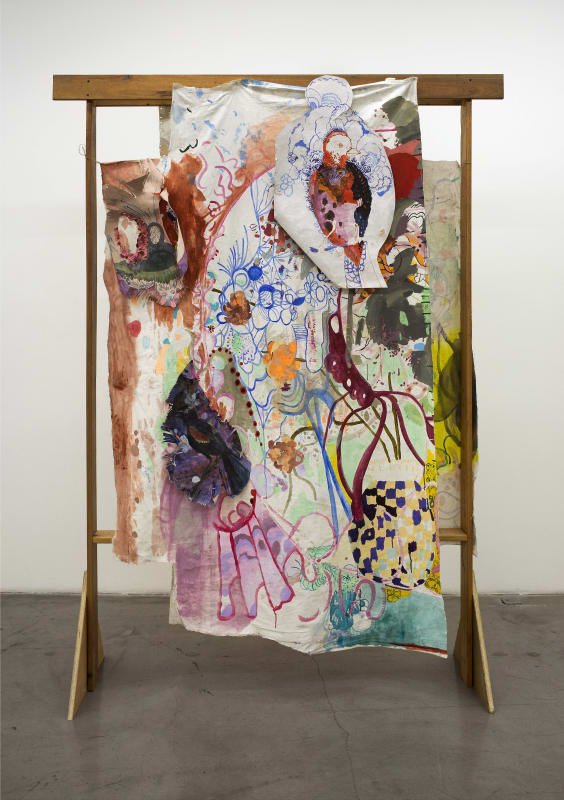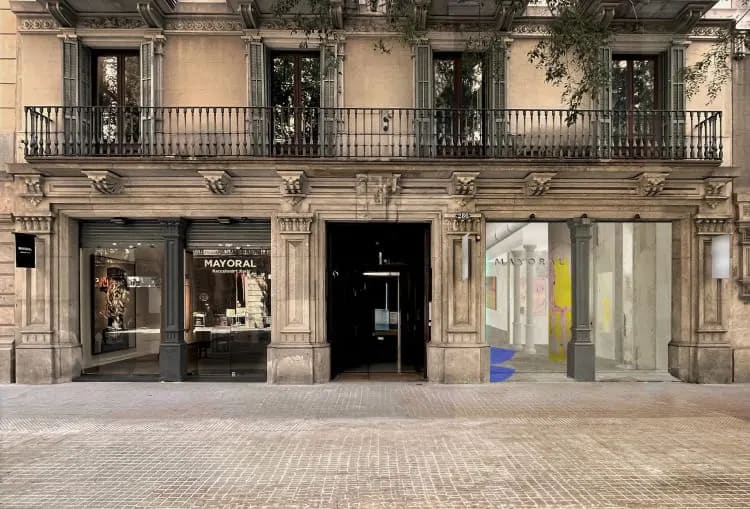| Catalan version |
| Spanish version |
In November 2023, Catalina León and I ended up spending two weeks in residence together in the small town of San Carlos, Salta, Argentina. We were hosted by the Museo Jallpha Kalchaki as part of a cultural and experimental exchange between contemporary artists and local knowledges and crafts – from pottery to plant medicine. The air is arid in San Carlos – dust covers everything, and it is red, and yellow. Water comes to the town in trucks, and by the end of our trip, the water truck in the main square had none left. A sense of foreboding settled into the town.
Spending some time together like this, in isolation from the rest of our tethers and obligations, brought with it the opportunity for me to delve deeper into the emotional and intellectual core of Catalina’s work. The artist, who always travels with her unstretched canvases like a little suitcase of amulets, lays them on the ground, sings, dances, paints on them. She invites people to lie on top of them. She covers the surfaces with layers and layers of images and patterns, portraits, iconographies inspired by the history of Italian grotesque, animals, plants and patterns. The making is never over, busy as the canvases are with registering, recording on their surface the passing of people, the passing of time. Their support also registers the making and unmaking of matter: Catalina paints on plasterboard fragments, then scattered onto the ground; on unstretched canvas, layered until it creates spatial arrangements. She layers these landscapes with natural and decomposable materials, so that the works burst with life but are also relics, and we walkthrough her works with a combination of childish excitement and the attentiveness of an archaeologist.
When we first met, Catalina and I recognised in one another a shared passion for practices around death and dying. Anthropological retellings of death and mourning rituals the world over; reflections on our own death; an immersion in care practices in close proximity to the dying – all of these things brought us into conversations that went deeper than one would expect, and much faster. At the time we met, Catalina was writing an audio guide aimed at helping listeners create rituals and a deeper connection with their own mortality – replete with DIY home exercises, too. 18 years ago, alongside her artistic practice, Catalina began to work with people who are at the end of their lives and their families, and only a few years later, she founded Vergel, an art-led, palliative-care non-profit organisation looking after children with no cure and long-term illness. It is probably no surprise then that, after having shared more than one cry, the end of our residency period in Salta brought us to San Carlos’s cemetery, where we walked around for some hours, finding and sharing stories, flowers, drawings. Catalina’s and my ghosts strode along with us, occasionally poking at an emotional nerve, always left too exposed: in a cemetery, like at a funeral, one person’s death is everybody’s death.
It was in the exuberance of iconography and decoration that characterises death in Latin America, that I realised that Catalina’s extraordinarily joyful, layered paintings and installations, replete with fish, birds, flowers, colour, leaves stitched together with thread, plasterboard fragments individually adorned, soil and fruits, were a long-durational experiment to bring life and joy to the grieving process. A bit like Penelope, really. Too often, when we make sense of her story, Penelope unweaves her textile at night in order to never finish daytime’s weaving work. But in its stead, the psychoanalyst Jean Laplanche once asked himself, could it not be the other way around? Could she not be weaving during the day in order to never be finished unweaving at night – in order for the work of mourning never to complete? As we imagine, and in imagining, we peel, layers and layers of time within Catalina’s work, we are also repeating a ceremony as old as human time: retelling, remembering, transforming in order to both let go and hold on.
In her cosmic, astrologically-influenced worlds, Catalina infuses intimacy and connection. For the exhibition at Mayoral, Catalina León has chosen, for a title, the word agñipé. It is a neologism, which the artist sought in order to anchor the exhibition to those energies or ideas that entered into dialogue with the works as they were being made. She sends me her definitions as she boards a flight to Italy:
Agñipé n.
1 Hot day in the middle of winter.
2 Something beautiful that appears without looking for it.
3 Bittersweet taste.
4 Bubbly feeling after dancing a lot.
5 Lucidity achieved on deciding not to understand something.
As an artist, and as a human being, Catalina bursts with agñipé. It only takes a second to realise. The same abundance, exuberance, dedication to – no: commitment to love holds all of agñipé’s definitions together, as well as the emotional and spatial landscapes Catalina creates through canvas and situation. Reading them, I imagine an adult’s flashy, fuzzy, broken-up memories of childhood summers. Or Catalina’s rooms and canvases, her altars and temples, full of living and lived material. Or again, that gentle high that heralds the beginning of love. In her last definition, as in the rest of the work, we find an invitation: “Lucidity achieved on deciding not to understand something”. Which is exactly what happens when, wanting to return to the world, we fold back into it, and at that very same moment we come to realise that the deepest possible meaning found in existence is completely immanent, or at the very least completely adherent, to existence itself, births as we birth, unspools as we unspool.
Lucia Pietroiusti



